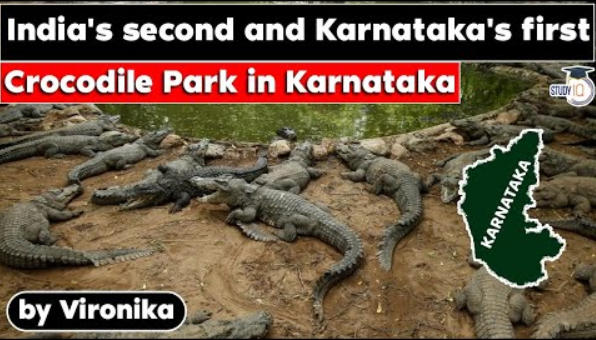Table of Contents

- The first ever in Karnataka and the second ‘Crocodile park’ in India has been opened for the public at bank of Kali river in front of Dandelappa temple in Dandeli of Uttara Kannada district.

- The first Crocodile park of Karnataka has been developed in two acre land near ancient Dandelappa temple at the banks of Kali river in Dandeli.
- To make the park more attractive, replica’s of the crocodile and other wild animals have also developed here.
- The lawn, sculptors of crocodiles, deer, giraffes, pergola facility with sitting arrangements and play equipment for children are the chief attractions. There are watchtowers to facilitate the visitors to have glimpses of the crocodiles.
- Three location have been identified to watch crocodiles. Entry for the park is free. However, a nominal entrance fee is likely to be charged for the watchtowers. The timing for the public is yet to be decided.
- It has been developed in the cost of Rs 3.5 crore in collaboration with the tourism department and PWD department. There is supportive environment for the Eco-tourism in the dense forest of Dandeli-Joida. This initiative will encourage tourism as well as create jobs to the local residents.
India’s First Crocodile Park
- Earlier there was only one such large scale crocodile park in India and that was Madras Crocodile Park.
- However various states are now constructing their own large scale crocodile parks which are expected to be operational in the coming years soon.
Madras Crocodile Park
- It started in 1976 by American-born snake expert Romulus Whitaker, who has also won recognition for his conservation work, the park is spread over 8.5 acres.
- It is home to more than 2,000 crocodiles and alligators, as well as reptiles such as turtles, tortoises, lizards and snakes




Crocodilian Species Found in India
Saltwater Crocodile (Crocodylus Porosus)
- Saltwater Crocodile is the largest living reptile in the world, live in mangrove forest of sunderbans, swamps of Bhitarkanika and near the lower stretches of rivers.
- The saltwater crocodiles are also found coastal areas of the Andaman and Nicobar Islands and within the Bhitarkanika Wildlife Sanctuary of Odisha.

Gharial (Gavialis Gangeticus)
- Gharial or the fish eating crocodile is one of longest living crocodiliansin the world, found in northern part of the Indian Subcontinent.
- The gharial is listed as Critically Endangered due to the loss of riverine habitat, now only found in Chambal River.
Mugger (Crocodylus Palustris)
- Mugger Crocodile is a medium-sized crocodile, only found throughout the Indian subcontinent.
- The mugger are ambush hunters that mostly inhabits freshwater lakes,rivers, marsh and swamps forest of India.
- The Mugger Crocodiles are the India’s most commonly seen river predators.
Human-Crocodile Conflict
- The biggest cause of the decline in the population of Indian crocodiles is the fact that their habitats are being destroyed for selfish human reasons.
- Urbanization and encroachment of humans on the river banks and marshy areas are the key causes of the human-crocodile conflict.
- In India, Vadodara, Kota, and Bhitarkanika are considered as the major human-crocodile conflict hotspots. The Andaman and Nicobar Islands are also a part of this list.
Question:
Which of the following statement is correct about the National Park?
- Multipurpose protected areas to preserve genetic diversity in representative ecosystem.
- A reserves area meant for preserving its natural vegetation, wildlife and natural beauty.
- A reserved area meant for preservation and development of endangered speicies.
- All of the above






















 WhatsApp
WhatsApp